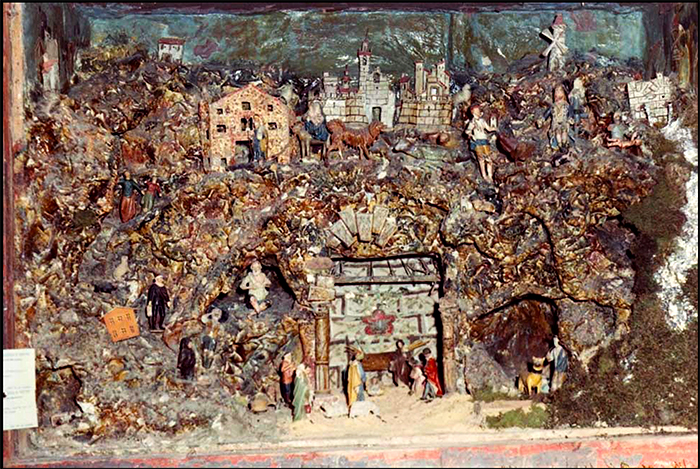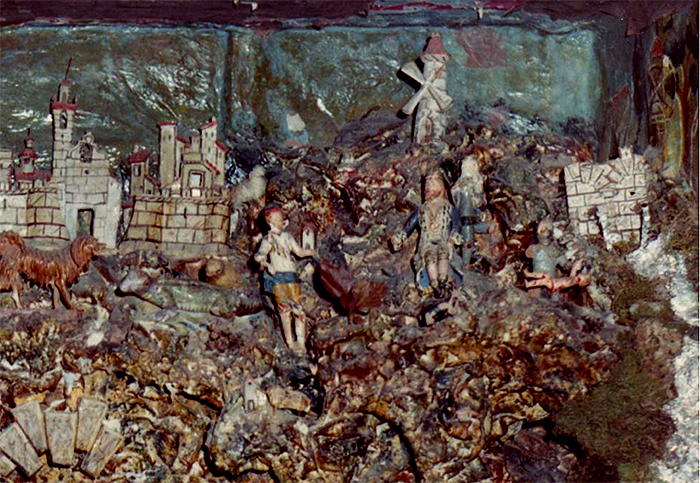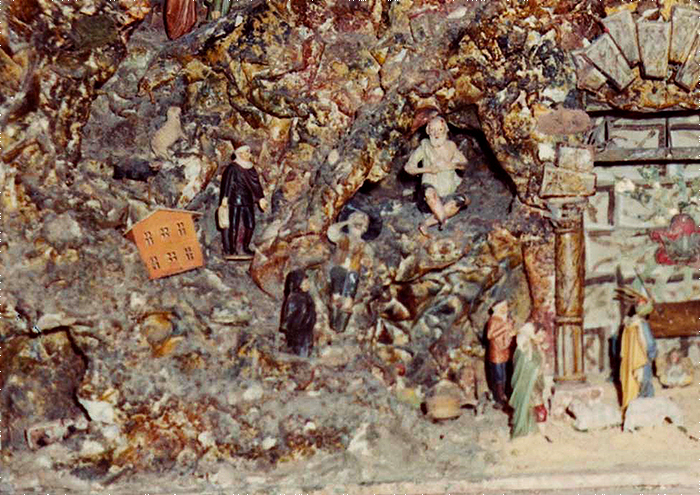The piece of the month of January 2024
THE OLD SHOWCASE OF THE NATIVITY SCENE OF THE MONASTERY OF TULEBRAS
Ricardo Fernández Gracia
Chair of Navarrese Heritage and Art
University of Navarra
Showcases or theaters with nativity scenes
An interesting chapter among the historical nativity scenes is constituted, also in Navarre, by a series of handicrafts that came out of the Navarrese cloisters and were destined, on many occasions, to protectors and donors. These are the so-called showcases, defined by the Diccionario de Autoridades ( 1732) as "jewels made in the manner of a cupboard with its doors and shelves inside to keep jewellery, fine clay and other delicate things, which women use a lot in their rooms to keep their charms". Those pieces formed an inseparable and singular part of the Hispanic noble interiors. This is reflected in 1690 by the Baroness d'Aulnoy in her Relation d'un voyage en Espagne, who enthusiastically describes the Spanish showcases as "a kind of cabinet Closed with a large crystal and full of everything that is possible to imagine of the rarest", being these "the most beautiful thing I have found there [in Spain]".
The Augustinian Recollect Nuns of Pamplona keep with care and great appreciation some of them. In 1731, they would invent: "two ebony showcases with their crystals on three sides, in one is the Adoration of the Kings and in the other the Flight into Egypt". In the same year, among the goods of Teresa Sos, mother of Don Fermín de Lubián, future prior of the cathedral of Pamplona, "a crib in its drawer" is noted.
José Luis Arrese points out that, at the end of the 18th century and part of the following century, a singular craft flourished in the convent of Araceli de Carmelitas Descalzas de Corella, of which curious examples are still preserved and which consisted of the construction of these small showcases, normally in the form of a box that contained in its interior, visible through a glass in the front, different themes composed of polychrome figures of clay or wax. In them the nuns refined their hands with silks, pieces of spurs and silver filigree. Four are preserved in the Museum of the house of Arrese, among which deserves special accredited specialization one dedicated to the Nativity in a greenish glass urn in the shape of a bell.
The Capuchin nuns of Tudela kept a couple of curious showcases, where it is difficult to locate the figures themselves, due to the abundance of small animals and flowers, which speak of the horror vacui that characterizes this subject of works. The nuns made these small sets, elaborated with mixed techniques, based on clay figures, breadcrumbs, paper, cardboard, fish scales, gold and colored metal sheets, waxes and rich fabrics.
The interest of these reductions lies in the fact that, frequently, they translate with certain fidelity, the way of placing the great figures in the nativity scenes at that time, constituting authentic historical testimonies, since the figures and the complete nativity scenes have disappeared.
A couple of notable examples belonged to the 19th century. The first, of the Poor Clares of Fitero, was made in Calatayud in 1847 and, at present, only its figures are preserved in a new assembly, in the Poor Clares of Tudela. Of the second, belonging to the Benedictine Sisters of Estella, we only have the documentation that informs us how in 1884: "a very beautiful nativity scene was bought that forms a very picturesque mountain with its paths or roads where the shepherds and shepherdesses go down to offer their humble gifts to the Divine Infant who is at the foot of the mountain in his small portal. It has a water tank and all over the field, through the moss, shines the frost or dew, which makes a very poetic effect. It cost twelve and a half duros, including postage. A gift from Doña Cirila Medievilla, mother of Mrs. Garcías. May the Child Jesus reward your generosity, increasing the virtues in your soul".
The monastery of Tulebras
A photograph taken in 1968, on the occasion of its exhibition in the capital of Navarre, in a sample in the Caja de Ahorros Municipal de Pamplona, provides us with the knowledge of the showcase of the nativity scene of the monastery of Tulebras. Unfortunately, the set is no longer preserved, so the snapshot, although not of great quality, is of great importance, as it is the only testimony we have left of the piece.

Nativity scene window of the monastery of Tulebras. Photograph of 1968, conserved in the file of the Monastery.
As in other Catalan, Valencian or Andalusian cases, the great showcase was organized with a large mountainous landscape, made with corks and glued and painted papers. In the lower part there is a grotto with the Nativity with the Adoration of the Kings, the latter without the horses and approaching the portal, which retains part of a symbolic arch with its classical ruins. Among the groups, the one of Herod's soldiers raging against the children with their knives, as well as the Annunciation, stand out. Houses of different sizes are dotted throughout the mountainous and rugged landscape, as well as small polychrome clay figures that do not seem to be from Murcia, but rather of Catalan origin.

Detail of the window of the nativity scene of the monastery of Tulebras. Photograph of 1968, conserved in the file of the Monastery.
In this monastery, as in others, the placement of the nativity scene acquired a ritual and festive dimension during the Christmas period. The arrival of the figures from Olot that swept the taste and the markets also cornered this subject of pieces. The news of its exhibition in Pamplona is provided by a grade of the then abbess, Sister Isabel Íñigo, in which it is noted: "Our nativity scene that was exhibited in the Caja de Ahorros de Pamplona in Christmas of 1968".

Detail of the window of the nativity scene of the monastery of Tulebras. Photograph of 1968, conserved in the file of the Monastery.
BIBLIOGRAPHY
ARRESE, J. L., Arte religioso en un pueblo de España, Madrid, CSIC, 1963.
FERNÁNDEZ GRACIA, R., Historical Nativity Scenes in Navarra. Figures for the report, Pamplona, Chair de Patrimonio y Arte Navarro, 2005.
FERNÁNDEZ GRACIA, R., To Bethlehem shepherds! Belenes históricos en Navarra, Pamplona, Government of Navarra-Pamplona City Council, 2007.
FERNÁNDEZ GRACIA, R., Tras las celosías. Patrimonio material e inmaterial en las clausuras de Navarra, Pamplona, University of Navarra - Fuentes Dutor Foundation, 2018.
